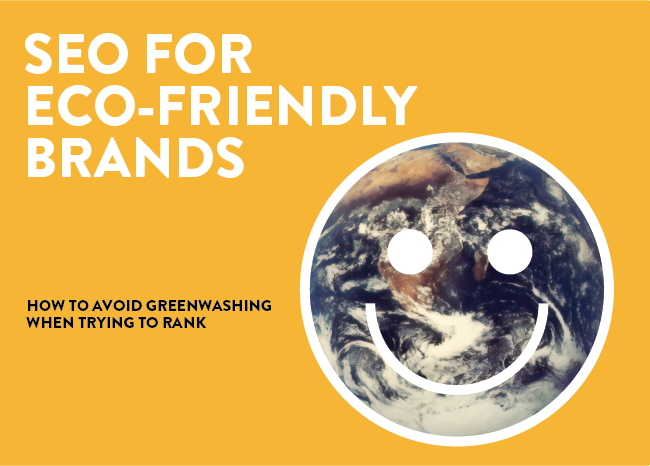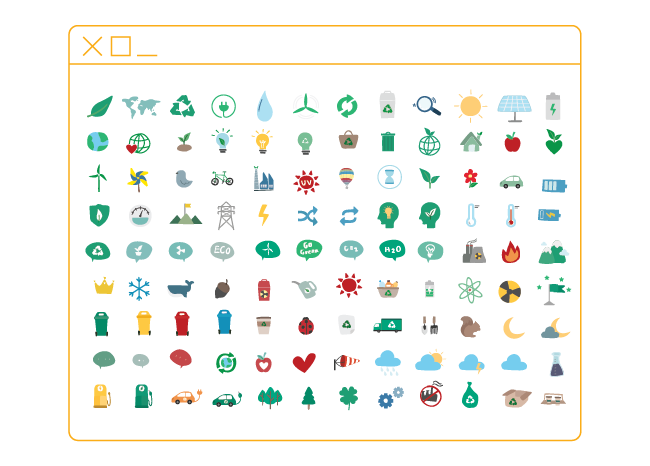 There is a significant volume of consumers who prioritize sustainable initiatives and often seek transparency from online brands — so much so that e-commerce posts about environmentalism receive almost eight times more engagement than other surface-level branding and promotion posts.
There is a significant volume of consumers who prioritize sustainable initiatives and often seek transparency from online brands — so much so that e-commerce posts about environmentalism receive almost eight times more engagement than other surface-level branding and promotion posts.
These people are increasingly looking to support brands that align with their identity and core values. This positions sustainable brands at the forefront of this movement. With this increased pressure to make your environmental efforts known, it may be difficult to navigate this fairly new arena.
If your company exists to protect the environment, this may come naturally. However, nearly any company can delve into the eco-friendly space. This may be beneficial when connecting with current and potential customers and clients, regardless of the space in which your business operates. Learn how to optimize your site to let search engines know you are serious about sustainability — and not just “greenwashing” your brand.
 What Is Greenwashing?
What Is Greenwashing?
Greenwashing, or “green sheen”, is performative environmentalism. It occurs when a company adds an eco-friendly spin to its brand or products. Greenwashing is typically deceptive — intentionally or unintentionally — and tricks many consumers into believing the brand is more eco-conscious than it is. This can be seen in:
- Green-colored packaging — without much context;
- Overuse of eco-friendly terms — such as “wholesome”, “natural”, or “clean”;
- Touting of eco-consciousness — without any facts to back up claims.
Often, brands that participate in greenwashing are hoping to jump on the eco-friendly bandwagon. This gives them the benefit of an increased customer base and loyalty without having to change their brand’s habits. These companies rely on customers to not research any further than these superficial claims. However, 81% of online consumers will research a product before making a purchase. This illustrates the importance of transparency if you want your brand to be successful in this eco-friendly era.
 How Does Greenwashing Affect Search Engine Optimization (SEO)?
How Does Greenwashing Affect Search Engine Optimization (SEO)?
Greenwashing can also delve into the world of SEO, by packing as many eco-friendly-sounding words into an article or other online content. In SEO terms, this is known as “keyword stuffing” — a generally frowned upon practice. Keyword stuffing is the practice of increasing your keyword density to try and increase ranking in search engine results.
Most search engines recognize this as spamming — a typical black hat SEO practice done when trying to influence the position a page has in search engine results. Even if you see positive traffic from keyword stuffing, it’s advisable to talk naturally about a chosen topic. This allows you the opportunity to showcase your brand’s authority and credibility in a certain niche — boosting signals to your site for relevant keywords. This is also the case when looking to establish credibility within eco-friendly spaces.
Greenwashing Hurts Your Credibility
When greenwashing, companies tend to overuse words like:
- All-natural;
- Biodegradable;
- Chemical-free;
- Clean;
- Eco-conscious;
- Eco-friendly;
- Environmentally friendly;
- Ethical;
- Fairtrade;
- Free of;
- Green;
- Hormone-free;
- Non-GMO;
- Non-toxic;
- Organic;
- Renewable;
- Sustainable.
With an expansive list of words that are commonplace in greenwashing tactics, it may be difficult to pick out the “right” words to use when your brand truly cares about the environment, and to illustrate that care to your audience. After all, nearly 71% of people in the U.S. believe that brands purporting to be eco-conscious are not telling the truth. What’s more, only 26% of people are very likely to believe brands that call themselves “green.”
How Search Engines View Sustainability Efforts
To accurately depict how sustainable your brand is, it’s important to understand how search engines view sustainability claims. In particular, Google has looked into ranking boosts for search results with sustainable benefits. However, the process has proven tricky at best.
Google Wants To Highlight Sustainable Choices
As part of an overarching eco initiative, Google announced an effort to bring consumers more sustainable choices. Most relevantly, this includes increased visibility for:
- Appliances with lower carbon footprints;
- Eco-friendly flight options;
- Electric and hybrid vehicles;
- Hotels with sustainability efforts.
 The catch with these upgrades is that they are typically in the “shopping” tab or within highlighted, interactive search results. This means that the information available to consumers is highly dependent on Google’s preference for brand categories — only including travel, auto, and appliance options. While this is a step in the right direction, it doesn’t have much bearing on the average company’s ranking solely based on sustainability efforts.
The catch with these upgrades is that they are typically in the “shopping” tab or within highlighted, interactive search results. This means that the information available to consumers is highly dependent on Google’s preference for brand categories — only including travel, auto, and appliance options. While this is a step in the right direction, it doesn’t have much bearing on the average company’s ranking solely based on sustainability efforts.
Green Results Are Reliant on Searcher Intent (For Now)
When a typical consumer is searching for a product, they may not include environmental keywords in their search query. This makes it difficult for search engines to sift out the sustainable search results for that query and place them at the top.
For example, searching for “dog food” won’t automatically bring you the most environmentally friendly dog food brands. Searching for “restaurants near me” won’t show you restaurants with the lowest carbon footprint or that use more organic ingredients.
Instead, users are expected to add these extra words to their search queries. Luckily, the increase in consumer preference for eco-friendly products helps in this process. This allows brands like you to optimize your pages and articles to satisfy searcher intent.
 How To Use SEO To Highlight Your Environmental Efforts
How To Use SEO To Highlight Your Environmental Efforts
If your brand is serious about sustainability, let that shine through naturally. It’s easier said than done, but it’s necessary to avoid greenwashing. This takes some forethought. Even if you aren’t intending on duping your readers and consumers, it takes work in this age of accountability. Otherwise, you may appear insincere simply due to the amount of deceit that runs rampant in the eco-friendly game.
Identify Eco Trends in Search
Pay attention to what big brands are saying about their sustainability. You can use Google Trends to identify popular keywords in the environmentally friendly space. Even better: check up on their claims to see if they can be substantiated. And even better than that, do keyword research on those terms. This will show you more information about these high-volume keywords. In particular, pay attention to:
- Existing top-ranking pages for each keyword;
- Monthly search volume (MSV);
- Keyword variations.
Often, the bigger head terms with high MSV will be difficult to rank for due to the amount of competition. Use tools like SEMrush to look at these analytics and dive deeper into related keywords and competitor content. Use these to guide your next moves. Ideally, create similar content with a fresh take.
Analyze Your Existing SEO
If you already have existing content on your website, you should use the same SEO tools to analyze performance. Most pertinently, check what keywords you are ranking for in at least the top 100 search results. Ask yourself:
- How much traffic is your site garnering from these keywords?
- What is the MSV of the keywords you are currently ranking for?
- Are the ranking pages directly or tangentially related to the purpose of your business?
- How many domains are linking to these pages?
- Are these pages useful to your target audience?
Sometimes, pages can be reoptimized for the keywords they are targeting. Evaluate if this is worth it based on relevance to your mission. Even if your content is sparse, you may have some pages that can help build an internal linking structure. This web of internal links helps boost signals to search engines that your brand is an authority on green subjects, as well as subjects closer to your brand's purpose. Typically, it’s best to start with foundational topics in your arena.
If this all seems overwhelming, it may be helpful to seek out SEO auditing services. SEO professionals can help maximize the potential of your existing content. They can also identify gaps in content to help you strategize your content going forward. This is particularly important when you are a brand within a specific industry that also wants to emphasize its eco-friendliness.
Hone in on Your Eco-Conscious Audience
To evaluate what characteristics make up your ideal client, it’s helpful to create a client profile as an example. It doesn’t have to match every single potential consumer, but it can give you a tangible person to imagine when tailoring your content.
For example, targeting younger generations may lead you to folks who care more about the environment, but they may not be able to pay an eco-friendly premium for your goods or services. Take the time to think about who would enjoy your products or services, who can pay for them, and who would care about the environmental impact of said products or services. What pain points can your brand solve for the environmentally-conscious consumer?
Be Ultra-Clear on the Definition of Eco Terms
Just because a term is trending, it doesn’t mean the big brands that are using it know what it means and are using it correctly. In reality, this is a large part of why greenwashing is so insidious. New terms for environmental issues and sustainability efforts pop up all the time. Then, they are overused by brands that are trying to appeal to an eco-conscious audience.
What these brands fail to realize is that those who care about environmental issues are more likely to research these terms. Slapping a green sheen on products may work fleetingly, but you want to create loyalty in your consumers. Focus on the longevity of using environmental terms and practices instead of jumping on trends too quickly. It may help to:
- Define terms — for yourself and the readers of your content;
- Link to credible sources — such as the CDC or EPA;
- Research variations of key terms — and choose the best term for the specific sustainability effort you are talking about.
While search engines like Google do a good job of recognizing different ways to search for the same result, eco-friendly terms are expansive. Knowing the small details of each term allows you to differentiate and speak to environmental issues and solutions accurately. It also helps your brand authentically connect to environmentalism without branching too far from your niche.
Narrow Your Niche — And Sprinkle Environmentalism Throughout
As previously stated, broad environmental terms are already oversaturated. This doesn’t mean that you can’t use them. You are encouraged to create foundational pages defining these terms so that you can internally link to them later. For instance, creating content that defines a water footprint will boost your credibility and provide a natural internal link when talking about your product’s water footprint.
Don’t Be Afraid of Going Full Eco-Focused (Sometimes)
Remember that you can talk about both your niche and eco-friendly topics, but they don’t always have to be combined. It may be difficult to stray completely from your specific business area — such as a beauty company writing content about animal testing. However, if your company is actively working on these environmental factors, it’s not as tangential as it seems.
An informed content creator will combine keyword-focused and linkable content to contribute to your overall content strategy. Start with keyword-focused content that is directly related to what your company offers. This builds the foundation for additional content. This additional content can reach a wider audience — such as eco-conscious consumers as a whole — and will be more appealing to external sources when procuring backlinks.
Focus on Expertise, Authority, and Trust (E-A-T)
To build trust in consumers, partners, and potential backlink sites, you must first focus on the integrity of your content. In the eco-friendly space, this involves much of the aforementioned tactics that are involved in E-A-T — such as:
- Appealing to a wider audience by procuring backlinks — through writing linkable content around sustainability;
- Backing up any environmental claims — with credible sources and internal “proof”;
- Defining environmentalism terms — when talking about your use of these eco-conscious practices to make it easier for readers to understand the impact;
- Identifying specific pain points of your ideal, eco-conscious client — and providing actual solutions;
- Only using eco terms that you understand — and explain how you incorporate them into your business clearly;
- Providing a link between your niche subject to the proper eco-friendly subject — by using internal links and mentioning each facet in adjacent articles.
Always remember to avoid using trendy terms just to appear eco-friendly. This undermines your actual sustainability efforts. Write with searcher intent in mind — picturing how your content will answer readers’ questions about how your brand contributes to an environmentally conscious society.
If you’re not following through on eco-friendly claims, start over until you can back up your claims. Ideally, create landing pages for consumers to head to and read about how your company is impacting the environment in simple, clear terms. The keyword-focused and linkable content will follow legitimate green practices, and you’ll gain loyal, eco-conscious clients that trust in your products and services along the way.

